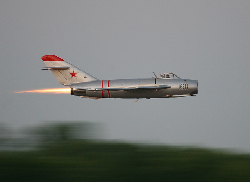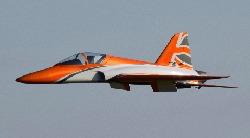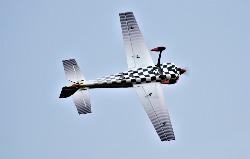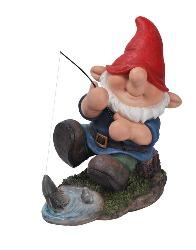- Thank you received: 0
Crosswind Flying Book
-
 Topic Author
Topic Author
- New Member
-

Less
More
9 years 10 months ago #7222
by
Crosswind Flying Book was created by
he takes 2 pages to discuss point rolls?? 2 pages!!!
let me fill that in for you;
put aileron in, let of aileron at appropriate moment, the most common is 4 and 8 points spread equally but any number is possible, use your imagination.
you can either put large amounts of aileron in for quick movements and fast stops or less aileron for long slow ones. and don't forget the appropriate amount of rudder and elevator to keep it straight just like you would do on any roll.
Ade's rules:
more throttle = better
slower roll = better
below =10ft is a must
bonus points for touching wingtips on the ground
done... see who need 2 pages!
let me fill that in for you;
put aileron in, let of aileron at appropriate moment, the most common is 4 and 8 points spread equally but any number is possible, use your imagination.
you can either put large amounts of aileron in for quick movements and fast stops or less aileron for long slow ones. and don't forget the appropriate amount of rudder and elevator to keep it straight just like you would do on any roll.
Ade's rules:
more throttle = better
slower roll = better
below =10ft is a must
bonus points for touching wingtips on the ground
done... see who need 2 pages!
Please Log in or Create an account to join the conversation.
- JRI
-

- Offline
- Platinum Member
-

Less
More
- Posts: 504
- Thank you received: 108
9 years 10 months ago #7223
by JRI
Replied by JRI on topic Crosswind Flying Book
I'm no expert, but to my mind the best way to learn a point roll is to learn to do a slow roll first and then hesitate at required points. That way you learn to feed in the correct amount of rudder and elevator rather than bung them in as afterthoughts at the points of hesitation. PS slow rolls are not as easy as they look but a well mixed model makes it easier.
Please Log in or Create an account to join the conversation.
-

- New Member
-

Less
More
- Thank you received: 0
9 years 10 months ago #7224
by
Replied by on topic Crosswind Flying Book
The main point of the book is suggesting where to hide the corrections within maneuvers. He suggest rolling the canopy into the cross wind that way you use up elevator to correct for drift, which is more natural than down elevator.
So in a point roll, my guess is his suggestion would be to roll the landing gear into the wind for the first part of the role, that way you can correct with the final half of the roll with the canopy into the cross wind.
I think it was Chris H who said to me one day, when doing a stall turn, turn into the wind, blindingly obvious, but I needed someone to suggest it before the light bulb went on. Same with this book, it's not that it's hard to understand, but there have been a couple of points where I've though, oh yeah!
So in a point roll, my guess is his suggestion would be to roll the landing gear into the wind for the first part of the role, that way you can correct with the final half of the roll with the canopy into the cross wind.
I think it was Chris H who said to me one day, when doing a stall turn, turn into the wind, blindingly obvious, but I needed someone to suggest it before the light bulb went on. Same with this book, it's not that it's hard to understand, but there have been a couple of points where I've though, oh yeah!
Please Log in or Create an account to join the conversation.
- JonTappin
-

- Offline
- Platinum Member
-

Less
More
- Posts: 1179
- Thank you received: 265
9 years 10 months ago - 9 years 10 months ago #7229
by JonTappin
Replied by JonTappin on topic Crosswind Flying Book
Hi Chris
Just had a chance to read the document. He uses a lot of words to explain what is actually quite basic.
To correct for wind drift, you need to keep the nose pointed sightly into wind at all times.
It is correct that there are 2 ways to do this, roll through each loop or part loop and use the rudder to yaw the nose into wind, the reality is that you need to do both of these things. In crosswinds you will always need to roll as you pull or push, then use rudder to make adjustments before, during and after the roll.
If you make yourself a stick plane it is much easier to visualise what I'm now going to attempt to explain. You are flying straight and level in a cross wind ready to enter a loop, you should already be yawed into wind to correct for drift. Because of this, when you pull or push the elevator, after the first 90 deg of pitch the wings will appear to have rolled. Imagine you are flying left to right, crosswind blowing in, so the nose will need to be yawed to the left (away) to correct the drift. If you now pull to a vertical in front of yourself, once vertical you will be looking at the top of the model, not looking straight down the wing as you should be, this is because you started with the nose slightly angled away from you. To correct this you need to roll very slightly left as you pull, roll the correct amount and your wings will be appear correct and you will maintain the nose angle away from you. Really hope that makes sense!
Use the rudder as well to make minor adjustments and everthing will be perfect
The difficult part is now learning to be natural on the rudder which is THE most difficult control to master. You know that aileron is effectively reversed when you fly towards yourself and elevator is reversed when inverted, with rudder, there are multiple attitudes that you will find yourself in when you need to apply rudder and it can take years before you have the confidence to know you will apply it in the correct direction, but learn that skill your flying will improve dramatically. In the article he says that the top pilots make it look so easy, this is because they are constantly applying these little corrections before those watching have even realised they are required.
The other thing not mentioned is that wind correction is normally required for a partial cross wind/headwind so the adjustments need to be done to compensate for sideways and forwards and backwards drift, so in your pull to vertical described above, you need to keep the sidways yaw element and stop the pitch before true vertical so the nose ends up leaning slightly forward to counteract the downwind drift element as well.
Just had a chance to read the document. He uses a lot of words to explain what is actually quite basic.
To correct for wind drift, you need to keep the nose pointed sightly into wind at all times.
It is correct that there are 2 ways to do this, roll through each loop or part loop and use the rudder to yaw the nose into wind, the reality is that you need to do both of these things. In crosswinds you will always need to roll as you pull or push, then use rudder to make adjustments before, during and after the roll.
If you make yourself a stick plane it is much easier to visualise what I'm now going to attempt to explain. You are flying straight and level in a cross wind ready to enter a loop, you should already be yawed into wind to correct for drift. Because of this, when you pull or push the elevator, after the first 90 deg of pitch the wings will appear to have rolled. Imagine you are flying left to right, crosswind blowing in, so the nose will need to be yawed to the left (away) to correct the drift. If you now pull to a vertical in front of yourself, once vertical you will be looking at the top of the model, not looking straight down the wing as you should be, this is because you started with the nose slightly angled away from you. To correct this you need to roll very slightly left as you pull, roll the correct amount and your wings will be appear correct and you will maintain the nose angle away from you. Really hope that makes sense!
Use the rudder as well to make minor adjustments and everthing will be perfect
The difficult part is now learning to be natural on the rudder which is THE most difficult control to master. You know that aileron is effectively reversed when you fly towards yourself and elevator is reversed when inverted, with rudder, there are multiple attitudes that you will find yourself in when you need to apply rudder and it can take years before you have the confidence to know you will apply it in the correct direction, but learn that skill your flying will improve dramatically. In the article he says that the top pilots make it look so easy, this is because they are constantly applying these little corrections before those watching have even realised they are required.
The other thing not mentioned is that wind correction is normally required for a partial cross wind/headwind so the adjustments need to be done to compensate for sideways and forwards and backwards drift, so in your pull to vertical described above, you need to keep the sidways yaw element and stop the pitch before true vertical so the nose ends up leaning slightly forward to counteract the downwind drift element as well.
Last edit: 9 years 10 months ago by JonTappin.
Please Log in or Create an account to join the conversation.
- JonTappin
-

- Offline
- Platinum Member
-

Less
More
- Posts: 1179
- Thank you received: 265
9 years 10 months ago - 9 years 10 months ago #7230
by JonTappin
Replied by JonTappin on topic Crosswind Flying Book
Regarding wind correction in point rolls, I expect all it would have said is that in knife edge positions, use elevator to adjust for drift and when upright or inverted use rudder, when anywhere between, use both. Same principle, you just need to keep the nose angled into the cross wind.
In your post above, it would be no good waiting for the third point of the roll so you can use up elevator, as you would have already been blown off line before you got there. The reason he suggests rolling in a direction that means you use up elevator, is that it would feel more natural, but rolling the other way and using down elevator does the same job, rolling canopy into wind makes sense in a half roll, but in a full roll you will need to do both sides.
That must have been my longest ever post! Hope it made sense, next time we manage to get up to Cashmoor, I will try to remember to bring my stick plane, much easier to explain face to face.
In your post above, it would be no good waiting for the third point of the roll so you can use up elevator, as you would have already been blown off line before you got there. The reason he suggests rolling in a direction that means you use up elevator, is that it would feel more natural, but rolling the other way and using down elevator does the same job, rolling canopy into wind makes sense in a half roll, but in a full roll you will need to do both sides.
That must have been my longest ever post! Hope it made sense, next time we manage to get up to Cashmoor, I will try to remember to bring my stick plane, much easier to explain face to face.
Last edit: 9 years 10 months ago by JonTappin.
Please Log in or Create an account to join the conversation.
- Chris73
-

- Offline
- Platinum Member
-

Less
More
- Posts: 492
- Thank you received: 83
9 years 10 months ago #7232
by Chris73
Replied by Chris73 on topic Crosswind Flying Book
Not much to remember then 
Please Log in or Create an account to join the conversation.
Moderators: DaveBright
Time to create page: 0.254 seconds
Latest Posts
-
-

- Ray Ivey's Models
- In WimborneMac Members / For Sale - Exchange - Wanted
- by Brian
- 1 week 6 days ago
-
-
-

- Various Gliders from Dave Ambrose ex W.M.A.C Membe...
- In WimborneMac Members / For Sale - Exchange - Wanted
- by 4Pedalsfly
- 3 weeks 2 days ago
-
©
2009 - 2025
WMAC PCF Design
